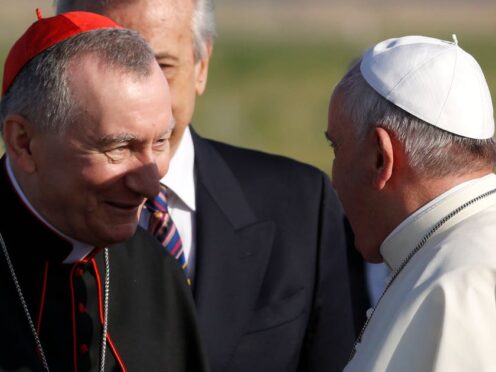The Vatican secretary of state is seeking to defuse outrage after Pope Francis’ comments that Ukraine should have the “courage of the white flag” to negotiate an end to the war.
Cardinal Pietro Parolin, the Vatican’s chief diplomat, insisted in media interviews that a primary condition for negotiations to end the war in Ukraine is an end to Russia’s aggression and that any peace must be a “just peace.”
Cardinal Parolin made the rounds with friendly Italian media the same day Kyiv summoned the Holy See ambassador to complain about the Pope’s comments.

Pope Francis’ remarks to Swiss broadcaster RSI, recorded in early February but only aired on Saturday, elicited immediate criticism from Ukraine and its allies, even after the Vatican press office tried to redirect attention to his other remarks in the interview that “negotiation is never a surrender”.
The ruckus once again put the Vatican’s diplomatic corps in the position of having to smooth over the Pope’s informal, off-the-cuff way of speaking, providing a more articulated position in line with the Holy See’s tradition of calibrated diplomatic neutrality.
In an interview with leading Corriere della Sera published Tuesday, Cardinal Parolin noted that Pope Francis in another speech last month had called for a diplomatic solution in Ukraine and the search for a just and lasting peace.
“In that sense, it is obvious that the creation of such conditions aren’t just for one side, but both sides, and the first condition would be that of putting an end to the aggression,” Cardinal Parolin said in comments that also were reported by the Vatican’s in-house Vatican News portal.
Cardinal Parolin noted that Francis’ “white flag” comments were in response to a question that used the term, and that the pontiff subsequently insisted that “negotiation is never a surrender”.
The cardinal made similar comments to Italy’s state-run RAI, saying: “Peace in Ukraine will have to be a just peace.
“It means recognising mutual rights and also mutual duties, above all, taking into account the dignity of people.”
It is not the first time Pope Francis’ sometimes imprecise way of speaking, which is often appreciated in other contexts because of its simplicity, have created a diplomatic headache for the Holy See and angered one or the other side in the war.
He has repeatedly expressed solidarity with the “martyred” Ukrainian people but refused to call out Russia or President Vladimir Putin by name.
He has seemingly expressed understanding for the invasion Putin ordered by saying Nato was “barking at Russia’s door” by expanding east, but then earned a formal protest from Moscow when he blamed most of the cruelty on Chechens and other minorities.
In September, Pope Francis again courted the displeasure of Ukrainians, including its Greek Catholic bishops, when he praised Russia’s imperial past during a meeting with Russian youths.
After Ukrainians voiced their sense of betrayal, the Pope later acknowledged his words were “perhaps not happy” and that he in no way meant to justify Russia’s invasion.
